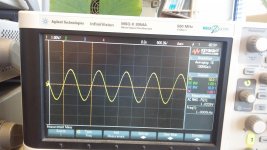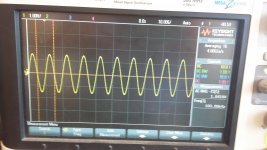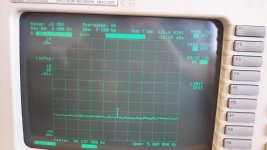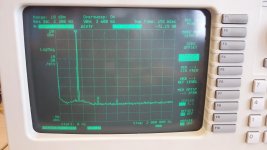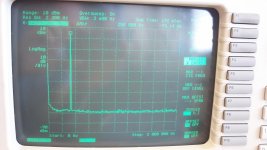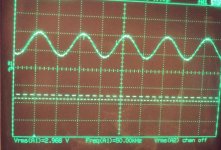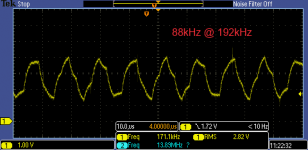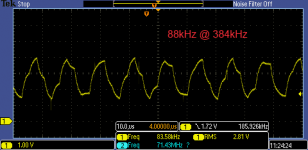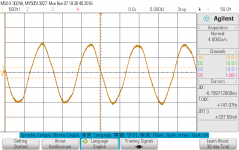FR of ES9038Q2M @768kHz samplerate, probed at output of analog filter with Fcut-off = 400kHz.
1k, 20k, 100k, 200k flat, at 350k drop 10% (may have been caused by the filter)
1k, 20k, 100k, 200k flat, at 350k drop 10% (may have been caused by the filter)
Attachments
Wideband frequency analysis:
Fig 1 - 350kHz@768kHz, I/V output, 2MHz range, no harmonics above -73dB analyzer noise floor
Fig 2 - 350kHz@768kHz, filter output, 2MHz range, the filter starts distorting, OPA1656s are too slow
Fig 3 - 350kHz@768kHz, I/V output - range up to 110MHz manually scanned, first peak located at MCLK 98.3MHz, -57dBm=320uVrms
Fig 1 - 350kHz@768kHz, I/V output, 2MHz range, no harmonics above -73dB analyzer noise floor
Fig 2 - 350kHz@768kHz, filter output, 2MHz range, the filter starts distorting, OPA1656s are too slow
Fig 3 - 350kHz@768kHz, I/V output - range up to 110MHz manually scanned, first peak located at MCLK 98.3MHz, -57dBm=320uVrms
Attachments
Last edited:
phpfman ask me to re post my measurements from another topic.
ADCs and DACs for audio instrumentation applications
ADCs and DACs for audio instrumentation applications
"directly" mean at DAC's pin before LPF?Originally Posted by phofman View Post
50kHz directly behind AK4493@768kHz
Sorry for the bad picture from old HP, newer scope is at another room.
This is AK4490@768 at pin 25:
My picture above was with 512fs (22/24MHz), so at 768 it was 32*768.
50kHz is non-integer samples per period and thus moving. Please try integer divider (e.g. 48kHz) or single-shot. IMO you will not see any oversampled points (only the original 16 points per period), unlike 48kHz at samplerate <=192kHz.
48kHz@768kHz, single shot.
Attachments
Altor, thanks. 16 points per period may be inconclusive. Please can you post single shot 88kHz at 192kHz and 384kHz? Thanks.
Done.
Reminder - this is 4490, not 4493!
Reminder - this is 4490, not 4493!
Attachments
Last edited:
What filter did you use in the AK4490?
It looks worse than a similar test I made long time ago. While not a perfect sine wave, it does look better than your measurement. I measured with an 80 kHz tone, not 88 kHz, but I don't expect that to make a big difference.
When scaling the sample rate and the output frequency it certainly looked bad 😱
It looks worse than a similar test I made long time ago. While not a perfect sine wave, it does look better than your measurement. I measured with an 80 kHz tone, not 88 kHz, but I don't expect that to make a big difference.
When scaling the sample rate and the output frequency it certainly looked bad 😱
Attachments
What filter did you use in the AK4490?
As I remember, in this device it was fixed to sharp.
I used the "Sharp roll-off filter", not the default "Short delay Sharp roll-off filter".
In parallel mode this requires that both SD and SLOW are low.
In parallel mode this requires that both SD and SLOW are low.
I used the "Sharp roll-off filter", .
The same, just in software mode.
This was supposed to be measured before the filter (at DAC output). The selected filter should not impact the results.
This was supposed to be measured before the filter (at DAC output).
Yes.
The selected filter should not impact the results.
We talked about the digital filter, before D/A conversion.
Altor, do you have your DAC switched to quad at 192kHz? Your results for 192kHz correspond to your and our measurements at octo mode where IMO no upsampling is applied.
Altor, do you have your DAC switched to quad at 192kHz?
Yes, DAC is in quad at 192, oct at 384 and hex at 768.
In this device I used 512fs clock (22/24MHz) and Auto Setting Mode (ACKS bit = “1”).
We talked about the digital filter, before D/A conversion.
Sorry for the misunderstanding.
I'm also puzzled by the NOS appearance of you 88k@192k in quad mode. If what was discussed earlier in this thread is valid there should be 2x oversampling at quad mode.
- Home
- Design & Build
- Equipment & Tools
- AK4493 at oct/hex sampling speeds - oversampling filter issue?
